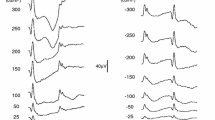Abstract
A tri-color Ganzfeld stimulator with light-emitting diodes as light sources is used to study the suppression of the second electroretinographic response in human eyes to double-flash stimulation. The mechanism suppressing the a- and b-waves of the response to the second (test) flash has a scotopic spectral sensitivity to the first (conditioning) flash. Responses to mild test stimuli are more sensitive to suppression by a conditioning flash than responses to strong test stimuli.
Similar content being viewed by others
Abbreviations
- ERG:
-
electroretinography/electroretinogram
- LED:
-
light-emitting diode
- phot.cd:
-
photopic candela
- scot.cd:
-
scotopic candela
References
Wagman IH, Waldman J, Naidoff D, Feinschil LB, Cahan R. The recording of the electroretinogram in humans and in in animals. Investigation of retinal sensitivity following brief flashes of light. Am J Ophthalmol 1954; 38: 60–9.
Mahneke A. Electroretinography with double flashes. Acta Ophthalmol 1957; 35: 131–41.
Burian HH, Spivey BE. The effect of twin flashes and of repetitive light stimuli on the human electroretinogram. Am J Ophthalmol 1959; 48: 274–86.
Arden G, Granit R, Ponte F. Phase of suppression following each retinal b-wave in flicker. J Neurophysiol 1960; 23: 305–14.
Troelstra A, Schweitzer NMJ. On the relationship between the single flash ERG and the ERG elicited by more complex stimuli. Doc Ophthalmol 1964; 18: 114–27.
Von Lützow A, Wündsch L. Grenzen der zeitlichen Summation im Doppelreiz-ERG des Kaninchens. Vision Res 1967; 7: 565–71.
Schulze J, Beddermann F. Remarkable difference in double-flash response in rod-dominated and mixed retina. Vision Res 1971; 11: 1221.
Algvere P, Westbeck S. Human ERG in response to double flashes of light during the course of dark adaptation: A Fourier analysis of the oscillatory potentials. Vision Res 1972; 12: 195–214.
Mitsyu M. The double-flash ERG during adaptation to the dark. Acta Ophthalmol 1978; 56: 291–301.
Dowling JE, Ehinger B, Hedden WL. The interplexiform cell: A new type of retinal neuron. Invest Ophthalmol 1976; 15: 916–26.
Holmgren I. Synaptic organization of the dopaminergic neurons in the retina of the cynomolgus monkey. Invest Ophtalmol Vis 1982; Sci. 22: 8–24.
Gottlob I, Wündsch L, Pflug R. Possible role of amacrine cells in the generation of the mammalian ERG b-wave. Doc Ophtalmol 1985; 61: 55–63.
Dowling JE. Dopamine: a retinal neuromodulator? Trends Neuro Sci 1986; 9: 236–40.
Schneider T, Zrenner E. Double-flash responses in different retinal layers. Ophthalmic Res 1987; 19: 193–9.
Salinger WL, Lindsley DB. The suppression-recovery effect and visual adaptation in the cat. Vision Res 1971; 11: 1435–44.
Kooijman AC, Damhof A. ERG lens with built-in Ganzfeld light source for stimulation and adaptation. Invest Ophthalmol Vis Sci 1980; 19: 315–8.
Kooijman AC. The homogeneity of the retinal illumination is restricted by some ERG lenses. Invest Ophthalmol Vis Sci 1986; 27: 372–7.
Kooijman AC, Damhof A. A tricolor light source for stimulation and adaptation in electroretinography. Doc Ophthalmol 1986; 63: 195–203.
Wyszecki G, Stiles WS. Color Science. New York: Wiley, 1967; 225.
Kooijman AC, Damhof A. ERG measurements with red and yellow-green LEDs as light source for stimulation and adaptation. Doc Ophthalmol Proc Ser 1982; 31: 31–8.
Author information
Authors and Affiliations
Rights and permissions
About this article
Cite this article
Kooijman, A.C., Zwarts, J. & Damhof, A. Double-flash electroretinography in human eyes. Doc Ophthalmol 73, 377–385 (1989). https://doi.org/10.1007/BF00154493
Received:
Accepted:
Issue Date:
DOI: https://doi.org/10.1007/BF00154493




